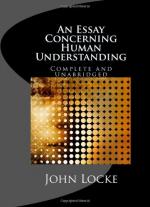20. Pound an almond, and the clear white colour will be altered into a dirty one, and the sweet taste into an oily one. What real alteration can the beating of the pestle make in an body, but an alteration of the texture of it?
21. Explains how water felt as cold by one hand may be warm to the other.
Ideas being thus distinguished and understood, we may be able to give an account how the same water, at the same time, may produce the idea of cold by one hand and of heat by the other: whereas it is impossible that the same water, if those ideas were really in it, should at the same time be both hot and cold. For, if we imagine warmth, as it is in our hands, to be nothing but a certain sort and degree of motion in the minute particles of our nerves or animal spirits, we may understand how it is possible that the same water may, at the same time, produce the sensations of heat in one hand and cold in the other; which yet figure never does, that never producing the idea of a square by one hand which has produced the idea of a globe by another. But if the sensation of heat and cold be nothing but the increase or diminution of the motion of the minute parts of our bodies, caused by the corpuscles of any other body, it is easy to be understood, that if that motion be greater in one hand than in the other; if a body be applied to the two hands, which has in its minute particles a greater motion than in those of one of the hands, and a less than in those of the other, it will increase the motion of the one hand and lessen it in the other; and so cause the different sensations of heat and cold that depend thereon.
22. An excursion into natural philosophy.
I have in what just goes before been engaged in physical inquiries a little further than perhaps I intended. But, it being necessary to make the nature of sensation a little understood; and to make the difference between the qualities in bodies, and the ideas produced by them in the mind, to be distinctly conceived, without which it were impossible to discourse intelligibly of them;—I hope I shall be pardoned this little excursion into natural philosophy; it being necessary in our present inquiry to distinguish the primary and real qualities of bodies, which are always in them (viz. solidity, extension, figure, number, and motion, or rest, and are sometimes perceived by us, viz. when the bodies they are in are big enough singly to be discerned), from those secondary and imputed qualities, which are but the powers of several combinations of those primary ones, when they operate without being distinctly discerned;—whereby we may also come to know what ideas are, and what are not, resemblances of something really existing in the bodies we denominate from them.
23. Three Sorts of Qualities on Bodies.
The qualities, then, that are in bodies, rightly considered are of three sorts:—




